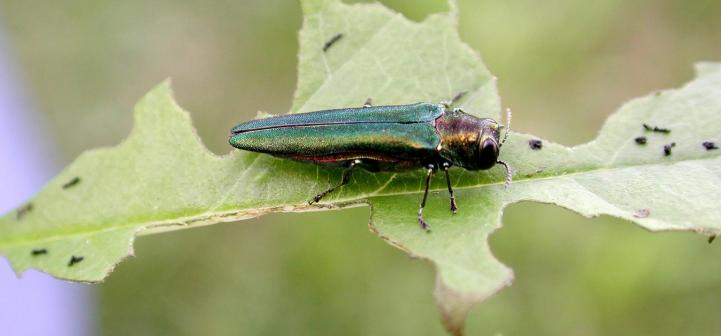Invasive Species: Myriophyllum heterophyllum, Variable Watermilfoil
Variable watermilfoil is an invasive perennial aquatic herb that has leaves of two noticeably different forms. The submerged leaves are finely dissected, whorled, reddish/greenish-brown, and 1/2 to 2 1/2 in. (1.3 to 6.4 cm) long. The emergent leaves are small, oval, bright green, whorled, and up to 1/4 in. (0.6 cm) wide. Emergent leaves stand 6 to 8 in. (15.2 to 20.3 cm) out of the water and may not be apparent until late summer. Flowering occurs from June to September. Flowers are emergent on 2 to 12 in. (5.1 to 30.5 cm) green to reddish stalks. Petals are less than 0.1 in. (3 mm) in length and are subtended by downward curved bracts. Fruits are small, nearly round, and have a rough surface. Variable watermilfoil is native to the southern United States but is considered invasive in much of the Northeast. This species is listed as endangered or threatened in three states (Kentucky, Ohio, and Pennsylvania).
What are invasive species and why should we be concerned about them?
Taxonomy: Scientific and Common Names for This Species
Haloragales > Haloragaceae > Myriophyllum heterophyllum Michx.
Synonym(s): twoleaf watermilfoil, broadleaf water-milfoil
Myriophyllum heterophyllum – USDA PLANTS Profile
Distribution Maps
Variable watermilfoil – The reported distribution of this invasive species across the United States. (Source: Invasive Plant Atlas of the United States)
Up-to-the-minute distribution maps and why they are important
Reporting This Invasive Species
What is the best way and place to report the occurrence of an invasive species?
How to report an invasive species sighting to EDDMapS – Early Detection & Distribution Mapping System
EDDMapS – Report an invasive species to EDDMapS
Cooperative Extension Offices – Find your local Cooperative Extension office on this map provided by USDA
How to Identify
This invasive species can be identified by looking for the characteristics described in the paragraphs that follow.
Plant
An invasive perennial aquatic herb that has leaves of two noticeably different forms.
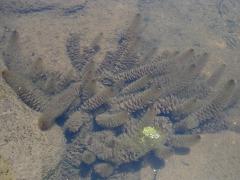 |
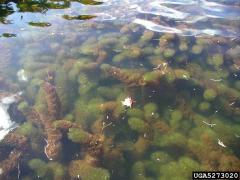 |
| Graves Lovell, Alabama Department of Conservation and Natural Resources, bugwood.org | Leslie J. Mehrhoff, University of Connecticut, bugwood.org |
Foliage
The submerged leaves are finely dissected, whorled, reddish/greenish-brown, and 1/2 to 2 1/2 in. (1.3 to 6.4 cm) long. The emergent leaves are small, oval, bright green, whorled, and up to 1/4 in. (0.6 cm) wide. Emergent leaves stand 6 to 8 in. (15.2 to 20.3 cm) out of the water and may not be apparent until late summer.
 |
|
| Leslie J. Mehrhoff, University of Connecticut bugwood.org | Graves Lovell, Alabama Department of Conservation and Natural Resources, bugwood.org |
Flower
Flowering occurs from June to September. Flowers are emergent on 2 to 12 in. (5.1 to 30.5 cm) green to reddish stalks. Petals are less than 0.1 in. (3 mm) in length and are subtended by downward curved bracts.
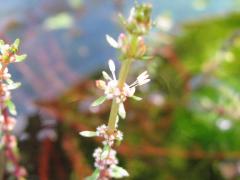 |
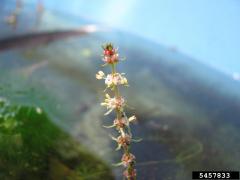 |
| Leslie J. Mehrhoff, University of Connecticut, bugwood.org | Leslie J. Mehrhoff, University of Connecticut, bugwood.org |
Fruit
Fruits are small, nearly round, and have a rough surface.
| bugwood.org | bugwood.org |
Native Species That Resemble Variable Watermilfoil
– Images at invasive.org
| bugwood.org | bugwood.org |
– Images at invasive.org
| bugwood.org | bugwood.org |
Additional Images for Variable Watermilfoil
Variable watermilfoil – Images at Invasive.org
Learning Resources for Variable Watermilfoil
Myriophyllum heterophyllum Identification Card – U.S. Fish & Wildlife Service
Myriophyllum heterophyllum Fact Sheet – U.S. Fish & Wildlife Service
Additional Information, Biology, Control and Management Resources
Control and management recommendations vary according to individual circumstances. Location, habitat, weather, and a variety of other conditions are factors that help determine the best treatment choice. To find the safest and most effective treatment for your situation, consult your state’s land-grant institution. If you will use chemicals as part of the control process, always refer to the product label.
United States Land-Grant University System – Find your land-grant university’s College of Agriculture, Cooperative Extension Service, or other related partner on this map provided by USDA.
Invasive Plant Atlas of New England – EDDMapS
Center for Aquatic and Invasive Plants – University of Florida, IFAS
Environmental Fact Sheet – NHDES
Plant Fact Sheet – Washington State Noxious Weed Control Board
Invasive Species Compendium – CABI
Global Invasive Species Database – Invasive Species Specialist Group
